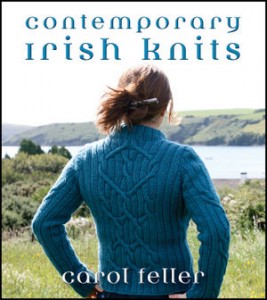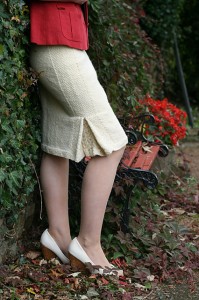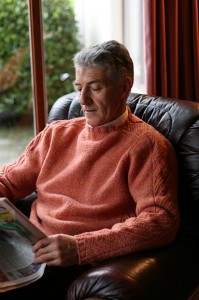Contemporary Irish Knits
By JC | September 29, 2011
Have your heard? Carol Feller puts a new spin on traditional Irish knits in Contemporary Irish Knits, a collection of fresh and exceptionally wearable designs.
My favorites are Tralee and Knockmore.
Beyond the designs, the book also includes fascinating portraits of the three remaining mills in Ireland that produce yarn for hand knitters. Actually, discovering that only three remained was what prompted Carol to write the book—who would’ve thought that, with Ireland’s rich knitting history, only three such mills would be left?
As part of a CIK blog tour, I got a chance to ask Carol some questions about the process of putting the book together. (No surprise, eh? I’m a process knitter.) Here goes:
With four boys, how on earth did you find the time to do all your research, designing, and writing?
Fortunately they are all in school now; my youngest started last year. He is finished fairly early (at 1pm) so you have to make every second count. That said, when you’re used to having little or no time by yourself, those mornings seem like an eternity (at least for the first week of the school year!) I try not to do anything but knitting related work in the mornings, designing, writing for the blog, etc. Dishes, cooking, laundry, etc. are done during homework time or at weekends (or not at all).
I actually think that when you have a very tight time frame to work in, that it’s easier to focus. I’m not sure that I’ll end up getting considerably more done even when the school days becomes longer. Without the clock ticking, I can lose hours of work site-hopping online (please tell me that I’m not the only one)!
I also almost never actually knit during the day. Knitting is my evening indulgence, when the younger kids have gone to bed.
When I showed your book to my local knitting buddies, everyone agreed: the garments are as wearable as they are lovely, and—courtesy of your husband—the photography is stunning. What was it like, working with your husband on the photo shoots? Had you worked together like this before?
Joe and I have been collaborating since I started designing – he does the photography and layout for all my self-published work. Previously in the blog tour, I answered a similar question from Shannon Okey, so I thought this time I’d hand the mic to Joe so he could give his perspective!
From Joe:
As Carol said, we’ve been working together on the photos and pattern layout from the beginning, which I’m grateful for in a few ways. First, because my “day job” is very verbal, and the photography provides the opportunity to be visually creative, which I crave. Second, because I am (without bias, of course) a real fan of Carol’s work – I think she has created some truly beautiful designs and I love helping her bring those designs to the public. Finally, and most importantly, the collaboration means we get to spend a lot of time together (free time is in short supply in our household). Around Christmas of last year I remember clearly spending an evening together by the fire narrowing down the 1000-plus book photos into a short-list for the final cut, and reminiscing and laughing. You can’t really call that work.
The photography for the book was more challenging than for the self-published patterns. Part of the reason was a sense of pressure. Most of the self-published work is photographed within miles (or feet) from our house, and if a shoot goes badly or the weather turns ugly or the light isn’t just right you can always shoot again the next day. For the book, it was important for us to capture the landscape in which the various yarns were being created. But Donegal, for example, is an eight-hour drive from us, so we really did have a sense of “we just get one shot at this.” It was also a challenge working with a wider variety of models (even if they were mostly relatives). Carol and I have done so many photos together that we almost don’t need to talk during the shoot (other than an occasional joke if she starts to look too serious). With the models for the book, we all had to learn from each other from scratch.
One lesson I took from the experience is this: bring kids to the photo shoot. True, they distract the photographer (at least they distracted me) but that is more than made up for by the fact that they really put the models at ease. Almost everyone in the book was a first-timer modeling-wise and understandably nervous. The boys were the cure – look through the book, and wherever you see a really warm and genuine smile, chances are there is a kid just out of frame.
My local knitting buddies also commented that they could relate to your models, as they “look like regular people.” Some of the models were your sons. Were the other models your family and friends too? Did they look forward to helping out, or did they need some coaxing?
All the models were friends or family, so definitely ‘regular’ people! Everyone was really happy to be part of it; my younger cousin, modeling the Dalkey set, in particular was very excited to get a chance to model (although I think my dad, modeling Knockmore sweater, was just obliging me!) I was fairly cautious when asking people, and you know pretty quickly if someone is interested or not. It does make it extra special to pick up the book and personally know everyone photographed.
The models in the book were three of my boys, my father, my best friend’s husband, three cousins, my niece and my sister. I’ve had several family members wonder where my mother was, so I’m going to state for the record now – she didn’t want to be photographed!
In reading your book, I was surprised to learn that Irish mills currently blend New Zealand fleeces with Irish fleeces—though it makes sense, if what you want is a soft yet durable yarn. In doing your research, did you discover anything that surprised you?
The big surprise actually came before I started the book. In fact, it was a big factor in deciding to do the book in the first place. What surprised me is that there are only 3 mills currently producing commercial yarn for hand knitters in Ireland! I was simply astonished at this fact. That said, what these mills were doing was exciting, as was the incredible work of Irish hand dyers. I wanted my work, and this book, to contribute to the renaissance I see looming in the Irish knitting industry. I’ll leave the reinvention of Irish yarn to millers and dyers; my goal was to change the way knitters think about “Irish” patterns.
What was the most fun part of putting the book together?
I loved the beginning, the planning stage. That’s when you get to swatch ideas, draw sketches and put together a plan of what the book will look like. All the possibilities are still open and you want to see how everything will best fit together cohesively.
I also always enjoy the designing and knitting as well (probably goes without saying!), especially the excitement of seeing your mental image materialize into reality. It’s always magic. It doesn’t seem to matter how many designs I plan, it always gives me the same thrill.
What’s next? Do you have another book in the works?
I’m working on a smaller 7 pattern booklet for the yarn company Fyberspates that should be done in the next few months. After that I don’t have any longer term plans yet. I wanted to give plenty of time to promote CIK, and I knew if I began another bigger project too soon I wouldn’t be able to do the book justice.






2 Comments